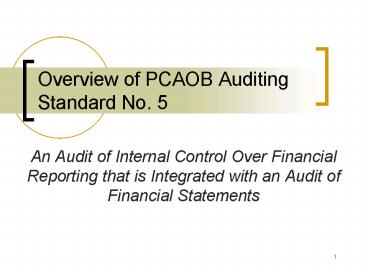Overview of PCAOB Auditing Standard No. 5 PowerPoint PPT Presentation
1 / 9
Title: Overview of PCAOB Auditing Standard No. 5
1
Overview of PCAOB Auditing Standard No. 5
- An Audit of Internal Control Over Financial
Reporting that is Integrated with an Audit of
Financial Statements
2
PCAOBs New Guidance for Audits of Internal
Control
- Issued May 24, 2007 to supersede PCAOB Auditing
Standard No. 2 - Responds to concerns about perceived
inefficiencies in initial years of AS2
implementation, without reducing audit
effectiveness - Retains most of the core concepts of AS2
described in Chapter 10 of Auditing Assurance
Services An Integrated Approach - Effective for audits of fiscal years ending on or
after November 15, 2007
3
Key Changes in AS5
- The new standard
- Emphasizes a top-down risk based approach
- Places greater reliance on entity-level controls
- Focuses on understanding and testing controls
related to risks for significant accounts and
disclosures - Allows for greater ability to rely on work of
others - Changes definition of material weakness and
significant deficiency - Simplifies the auditors opinion by eliminating
opinion on managements assessment of internal
control
4
Top Down Risk Based Approach
- Emphasizes auditor focus on controls related to
risks that might lead to material misstatements - Begins at the financial statement level with
consideration of risks affecting overall
financial statements - Leads to identifying and understanding
entity-level controls management has implemented
to address overall financial statement risks - Encourages auditor to consider entity-level
controls before assessing controls related to
specific objectives - Notes that fraud risk is an area of higher
overall risk requiring auditor to focus on
antifraud programs and controls - Recognizes that size and complexity of entity and
its processes affect the nature of risks and need
for related controls
5
Entity-Level Controls
- Focus on entity-level controls helps direct
auditor to controls related to high risk areas - Entity-level controls often include those related
to control environment, risk assessment, and
monitoring components of internal control - Leads to audit efficiencies by reducing tests at
transaction, account, or disclosure levels
because - Some entity-level controls indirectly affect
performance of other controls - Other entity-level controls directly monitor
operating effectiveness of other controls
6
Significant Accounts and Disclosures
- AS5 requires auditor to identify controls
relevant to significant accounts and disclosures - An account or disclosure is significant if there
is - a reasonable possibility that the account or
disclosure could contain a material misstatement
that, individually or when aggregated with
others, has a material effect on the financial
statements. - Represents a change from AS2, which required the
auditor to understand controls for each material
class of transactions within a single process - Likely will reduce the extent of walkthroughs the
auditor must perform - Emphasizes controls where risks of material
misstatements are highest
7
Using Work of Others
- Allows auditor to use the work of others to
obtain evidence about operating effectiveness of
internal controls - Includes work performed by company personnel or
others working under the direction of management
or audit committee - Tests performed by management to provide Section
404 assertion - Requires assessment of
- Competence and Objectivity of individuals
performing work - Relative risks associated with controls tested
8
Evaluating Deficiencies
- AS5 revises definitions of material weakness and
significant deficiency - Material weakness is
- a deficiency, or combination of deficiencies, in
internal control over financial reporting, such
that there is a reasonable possibility that a
material misstatement of the companys annual or
interim financial statements will not be
prevented or detected on a timely basis. - Significant deficiency is
- a deficiency, or combination of deficiencies, in
internal control over financial reporting that is
less severe than a material weakness, yet
important to merit the attention by those
responsible for oversight of the companys
financial reporting.
9
Auditors Opinion
- AS2 required two auditor opinions on
- Whether managements assessment of internal
controls was fairly stated - Whether internal controls over financial
reporting operated effectively - AS5 eliminates the first opinion
- Auditors opinion must only address whether the
company maintained, in all material respects,
effective internal control over financial
reporting as of the end of the fiscal year - Change affects auditors report wording in the
introductory and opinion paragraphs of the
combined report shown in Figure 3-3

